Environmental Impact of Fresh Tomato Production in an Urban Rooftop Greenhouse in a Humid Continental Climate in South Korea †
Abstract
:1. Introduction
2. Methodology Details
2.1. Fresh Tomato Production Process Details
2.2. Building Energy Simulation: Load Calculation Details.
2.3. LCA Methodology: Goal, Scope, and Functional Unit
2.4. Details of the Life Cycle Inventory
2.4.1. Infrastructure Inventory Inputs
2.4.2. Production Inventory Inputs
2.4.3. Energy Inventory Inputs
2.4.4. Distribution Inventory Inputs
3. Results
3.1. Life Cycle Impact Assessment
3.2. Life Cycle Interpretation
4. Further Considerations
5. Conclusions
Author Contributions
Funding
Conflicts of Interest
Abbreviations
| AD | abiotic depletion |
| AP | acidification potential |
| CED | cumulative energy demand |
| GH | conventional greenhouse |
| EU | eutrophication |
| FU | functional unit |
| GWP | global warming potential |
| LCA | life cycle assessment |
| LCI | life cycle inventory |
| LCIA | life cycle impact assessment |
| NPK | nitrogen, phosphorus, potassium |
| PO | photochemical oxidation |
| RTG | rooftop greenhouse |
Appendix A
| Infrastructure per m2 per Year | Unit | GH | RTG |
|---|---|---|---|
| Acrylic varnish, without water, in 87.5% solution state | kg | 1.1 × 10−3 | n/a |
| Agricultural machinery, unspecified | kg | 7.6 × 10−3 | 3.0 × 10−4 |
| Aluminum alloy, AlMg3 | kg | n/a | 1.1 × 10−1 |
| Aluminum scrap, post-consumer | kg | −6.0 × 10−3 | −1.0 × 10−1 |
| Aluminum, cast alloy | kg | 6.4 × 10−3 | n/a |
| Bitumen seal | kg | 1.0 × 10−4 | n/a |
| Blow molding | kg | 3.2 × 10−3 | 1.6 × 10−3 |
| Calendering, rigid sheets | kg | 1.0 × 10−2 | n/a |
| Concrete block | kg | 1.1 × 10−1 | n/a |
| Concrete, sole plate, and foundation | m3 | 3.8 × 10−4 | 7.3 × 10−3 |
| Copper | kg | 6.5 × 10−4 | 5.0 × 10−5 |
| Diesel, burned in building machine | MJ | 3.7 × 10−1 | 2.3 × 10−1 |
| Drawing of pipe, steel | kg | 3.2 × 10−1 | 1.6 × 10−1 |
| Electricity, low voltage | kWh | 6.0 × 10−2 | 3.0 × 10−2 |
| Electronics, for control units | kg | 1.6 × 10−5 | 1.5 × 10−3 |
| Ethylene vinyl acetate copolymer | kg | 1.2 × 10−1 | n/a |
| Extrusion, plastic film | kg | 1.7 × 10−1 | 2.7 × 10−2 |
| Extrusion, plastic pipes | kg | 4.4 × 10−2 | 2.2 × 10−2 |
| Flat glass, uncoated | kg | n/a | 6.5 × 100 |
| Gas motor, 206 kW | p | 6.2 × 10−10 | 3.1 × 100 |
| Heat and power co-generation unit, 200 kW electrical | p | 6.2 × 10−10 | 3.1 × 10−10 |
| Glass fiber reinforced plastic, polyamide, injection molded | kg | 8.0 × 10−5 | n/a |
| Injection molding | kg | 2.1 × 10−2 | 1.1 × 10−3 |
| Iron scrap, unsorted | kg | −6.0 × 10−1 | −2.0 × 10−1 |
| Oil boiler, 100 kW | p | 1.9 × 10−6 | 9.3 × 10−7 |
| Polycarbonate | kg | 1.0 × 10−2 | n/a |
| Polyester resin, unsaturated | kg | 1.4 × 10−3 | n/a |
| Polyethylene, high density, granulate | kg | 4.7 × 10−2 | 2.4 × 10−2 |
| Polyethylene, linear low density, granulate | kg | 4.8 × 10−2 | 2.7 × 10−2 |
| Polymer foaming | kg | 4.9 × 10−3 | 2.5 × 10−3 |
| Polypropylene, granulate | kg | 3.2 × 10−4 | n/a |
| Polystyrene, expandable | kg | 4.9 × 10−3 | 2.5 × 10−3 |
| Polyvinylfluoride | kg | 2.1 × 10−2 | 4.9 × 10−4 |
| Section bar extrusion, aluminum | kg | 6.4 × 10−3 | 1.1 × 10−1 |
| Section bar rolling, steel | kg | 2.3 × 10−1 | 8.9 × 10−2 |
| Sheet rolling, steel | kg | 3.6 × 10−2 | 1.8 × 10−2 |
| Silicone product | kg | 1.2 × 10−4 | n/a |
| Steel, chromium steel 18/8 | kg | 3.4 × 10−2 | 1.6 × 10−2 |
| Steel, low-alloyed | kg | 5.7 × 10−1 | 4.5 × 100 |
| Synthetic rubber | kg | 3.0 × 10−4 | 1.5 × 10−4 |
| Tractor, four-wheel, agricultural | kg | 1.5 × 10−2 | 7.6 × 10−3 |
| Wire drawing, copper | kg | 1.8 × 10−3 | 1.4 × 10−4 |
| Zinc coat, coils | m2 | n/a | 9.3 × 10−3 |
| Waste management | |||
| Waste concrete | kg | n/a | 1.0E × 10−4 |
| Waste concrete | kg | n/a | 5.0E × 10−1 |
| Waste electric and electronic equipment | kg | n/a | 2.0E × 10−3 |
| Waste glass | kg | n/a | 4.0E × 10−3 |
| Waste glass | kg | n/a | 2.0E × 10−1 |
| Waste plastic, mixture | kg | n/a | 3.0E × 10−4 |
| Waste plastic, mixture | kg | 1.3 × 10−1 | 5.0E × 10−2 |
| Waste polyvinylchloride | kg | 2.0 × 10−4 | n/a |
| Waste polyvinylchloride | kg | 1.2 × 10−1 | n/a |
| Waste rubber, unspecified | kg | 6.9 × 10−6 | 3.0E × 10−6 |
| Waste rubber, unspecified | kg | 2.9 × 10−4 | 1.0E × 10−4 |
| Agricultural Inputs per kg per Year | Unit | GH | RTG |
|---|---|---|---|
| Ammonia, liquid | kg | 9.5 × 10−5 | 9.5 × 10−5 |
| Ammonium nitrate, as N | kg | 2.9 × 10−5 | 2.9 × 10−5 |
| Ammonium sulfate, as N | kg | 3.4 × 10−5 | 3.4 × 10−5 |
| Application of plant protection product, by field sprayer | ha | 6.2 × 10−6 | 6.2 × 10−6 |
| Irrigation | m3 | 1.4 × 10−2 | 1.4 × 10−2 |
| Nitrogen fertilizer, as N | kg | 1.9 × 10−3 | 1.9 × 10−3 |
| Potassium chloride, as K2O | kg | 8.7 × 10−4 | 8.7 × 10−4 |
| Potassium fertilizer, as K2O | kg | 6.8 × 10−4 | 6.8 × 10−4 |
| Potassium sulfate, as K2O | kg | 2.1 × 10−4 | 2.1 × 10−4 |
| Packaging, for fertilizers or pesticides | kg | 8.0 × 10−3 | 8.0 × 10−3 |
| Pesticide, unspecified | kg | 9.5 × 10−5 | 9.5 × 10−5 |
| Planting | ha | 2.1 × 10−6 | 2.1 × 10−6 |
| Stone wool | kg | 9.2 × 10−3 | 9.2 × 10−3 |
| Tomato seedling, for planting | p | 5.8 × 10−2 | 5.8 × 10−2 |
| Transport, tractor, and trailer, agricultural | tkm | 6.3 × 10−4 | 6.3 × 10−4 |
| Urea, as N | kg | 5.5 × 10−5 | 5.5 × 10−5 |
| Energy per m2 per Year | Unit | GH | RTG |
|---|---|---|---|
| Heat, central or small-scale, natural gas | MJ | 4.4 × 102 | 4.0 × 102 |
| Cooling, electricity, low voltage | kWh | 8.0 × 100 | 1.3 × 101 |
| Distribution per kg per Year | Unit | GH | RTG |
|---|---|---|---|
| Polyethylene, high density, granulate, recycled | kg | 1.2 × 10−1 | 1.8 × 10−3 |
| Folding boxboard/chipboard | kg | 1.4 × 10−1 | n/a |
| Transport, freight, 3.5–7.5 metric ton lorry, EURO6 | tkm | 2.0 × 10−3 | n/a |
| Transport, freight, 3.5–7.5 metric ton lorry, EURO6 | tkm | 3.2 × 10−1 | n/a |
| Transport, freight, 3.5–7.5 metric ton lorry, EURO6 | tkm | 7.0 × 10−4 | n/a |
| Electricity, low voltage | kWh | 7.3 × 10−4 | n/a |
| Losses | p | 10% | n/a |
References
- Foley, J.A.; Ramankutty, N.; Brauman, K.A.; Cassidy, E.S.; Gerber, J.S.; Johnston, M.; Mueller, N.D.; O’Connell, C.; Ray, D.K.; West, P.C.; et al. Solutions for a cultivated planet. Nature 2011, 478, 337–342. [Google Scholar] [CrossRef] [PubMed] [Green Version]
- Godfray, H.C.J.; Beddington, J.R.; Crute, I.R.; Haddad, L.; Lawrence, D.; Muir, J.F.; Pretty, J.; Robinson, S.; Thomas, S.M.; Toulmin, C. Food Security: The Challenge of Feeding 9 Billion People. Science 2010, 327, 812–818. [Google Scholar] [CrossRef] [PubMed] [Green Version]
- Tilman, D.; Balzer, C.; Hill, J.; Befort, B.L. Global food demand and the sustainable intensification of agriculture. Proc. Natl. Acad. Sci. USA 2011, 108, 20260–20264. [Google Scholar] [CrossRef] [PubMed] [Green Version]
- Ramankutty, N.; Mehrabi, Z.; Waha, K.; Jarvis, L.; Kremen, C.; Herrero, M.; Rieseberg, L.H. Trends in Global Agricultural Land Use: Implications for Environmental Health and Food Security. Annu. Rev. Plant Biol. 2018, 69, 789–815. [Google Scholar] [CrossRef] [Green Version]
- International Organization for Standardization. Environmental Management—Life Cycle Assessment—Principles and Framework (ISO 14040:2006). Available online: https://www.iso.org/standard/37456.html (accessed on 30 October 2020).
- Perrin, A.; Basset-Mens, C.; Gabrielle, B. Life cycle assessment of vegetable products: A review focusing on cropping systems diversity and the estimation of field emissions. Int. J. Life Cycle Assess. 2014, 19, 1247–1263. [Google Scholar] [CrossRef]
- Cerón-Palma, I.; Sanyé-Mengual, E.; Oliver-Solà, J.; Montero, J.I.; Rieradevall, J. Barriers and Opportunities Regarding the Implementation of Rooftop Eco.Greenhouses (RTEG) in Mediterranean Cities of Europe. J. Urban Technol. 2012, 19, 87–103. [Google Scholar] [CrossRef]
- Sanyé, E.; Cer, I.; Oliver-sol, J. Environmental analysis of the logistics of agricultural products from roof top greenhouses in Mediterranean urban areas. J. Sci. Food Agric. 2013, 100–109. [Google Scholar] [CrossRef] [PubMed]
- Droege, P. 100 Percent Renewable: Energy Autonomy in Action; Earthscan: London, UK, 2009; ISBN 978-1-84407-718-2. [Google Scholar]
- Heuvelink, E. Tomatoes; Heuvelink, E., Ed.; CABI: Wallingford, NY, USA, 2018; ISBN 9781780641935. [Google Scholar]
- Chung, M.H.; Park, J.C.; Ko, M.J. Effect of the solar radiative properties of existing building roof materials on the energy use in humid continental climates. Energy Build. 2015, 102, 172–180. [Google Scholar] [CrossRef]
- Bae, C.; Chun, C. Research on seasonal indoor thermal environment and residents’ control behavior of cooling and heating systems in Korea. Build. Environ. 2009, 44, 2300–2307. [Google Scholar] [CrossRef]
- Selina, P.; Bledsoe, M.E. U.S. Greenhouse: Hothouse Hydroponic Tomato Timeline. Available online: https://ipmdata.ipmcenters.org/documents/timelines/USgreenhousetomato.PDF (accessed on 27 October 2020).
- University of Wisconsin-Madison. Solar Energy Laboratory. In TRNSYS, a Transient Simulation Program; The Laboratory: Madison, WI, USA, 1975. [Google Scholar]
- Cho, J. The Feasibility Analysis of Economic and Environmental Impact of Air-Conditioning System for Greenhouse Usig Dynamic Energy Simulation. Master’s Thesis, Chungnam National University, Daejeon, Korea, 2020. [Google Scholar]
- International Organization for Standardization. Environmental Management—Life Cycle Assessment—Requirements and Guidelines (ISO 14044: 2006). Available online: https://www.iso.org/standard/38498.html (accessed on 30 October 2020).
- iPoint-Systems Gmbh Life Cycle Impact Assessment—Which Are the LCIA Indicator Sets Most Widely Used by Practitioners? Available online: https://www.ipoint-systems.com/blog/lcia-indicator/ (accessed on 24 September 2020).
- Merchan, A.; Combelles, A. Comparison of Life Cycle Impact Assessement Methods in a Case of Crop in Northern France. In Proceedings of the 4th International Conference on Life Cycle Approaches, Lille, France, 5–6 November 2014; pp. 3–6. [Google Scholar]
- Tobergte, D.R.; Curtis, S. ILCD Handbook; CRC Press: Boca Raton, FL, USA, 2013; Volume 53, ISBN 9788578110796. [Google Scholar]
- Gómez-López, M.D.; Martínez, S.; Gabarrón Sánchez, M.; Faz Cano, Á. Course—Life Cycle Assessment for a Sustainable Agriculture. Course Handout. 2017. Available online: http://www.agri-base.eu/wp-content/uploads/2017/05/LCA.pdf (accessed on 30 October 2020).
- Wernet, G.; Bauer, C.; Steubing, B.; Reinhard, J.; Moreno-ruiz, E.; Weidema, B. The ecoinvent database version 3 (part I): Overview and methodology. Int. J. Life Cycle Assess. 2016, 3, 1218–1230. [Google Scholar] [CrossRef]
- Sanyé-Mengual, E.; Oliver-Solà, J.; Montero, J.I.; Rieradevall, J. An environmental and economic life cycle assessment of rooftop greenhouse (RTG) implementation in Barcelona, Spain. Assessing new forms of urban agriculture from the greenhouse structure to the final product level. Int. J. Life Cycle Assess. 2015, 20, 350–366. [Google Scholar] [CrossRef] [Green Version]
- Pré Consultants. SimaPro (Release 8.5.2.0). 2017. Available online: https://simapro.com/ (accessed on 30 October 2020).


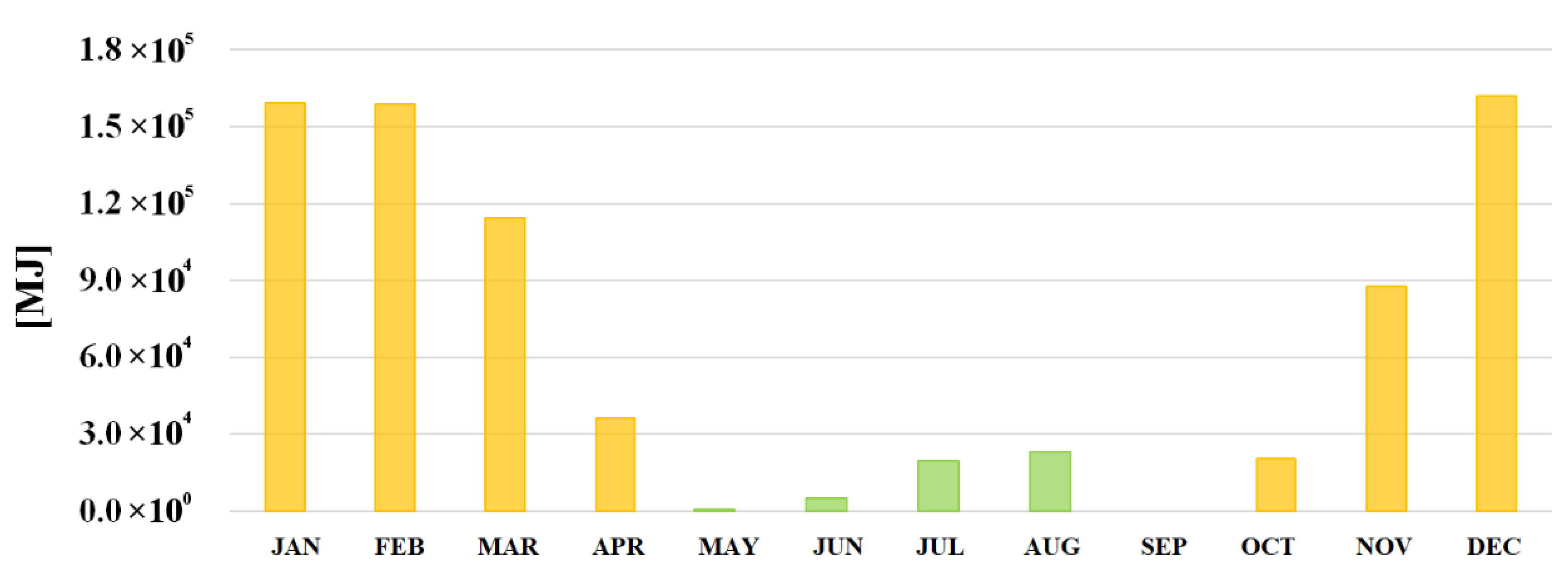
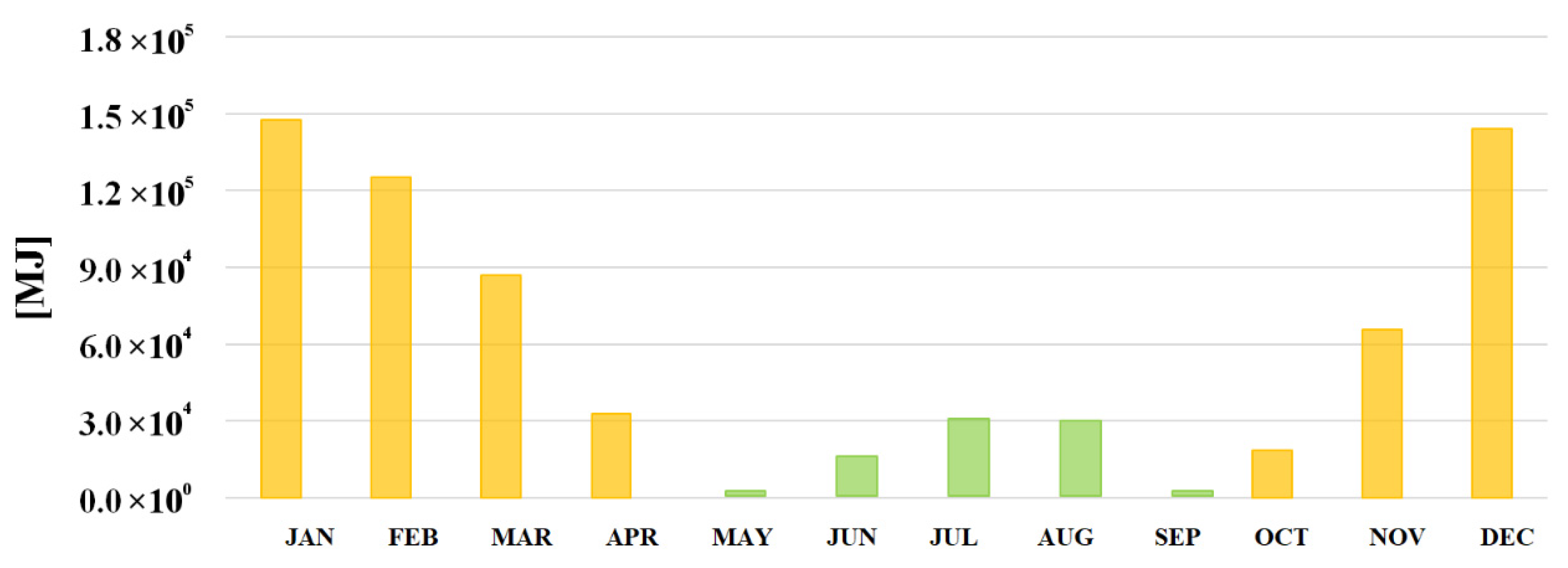

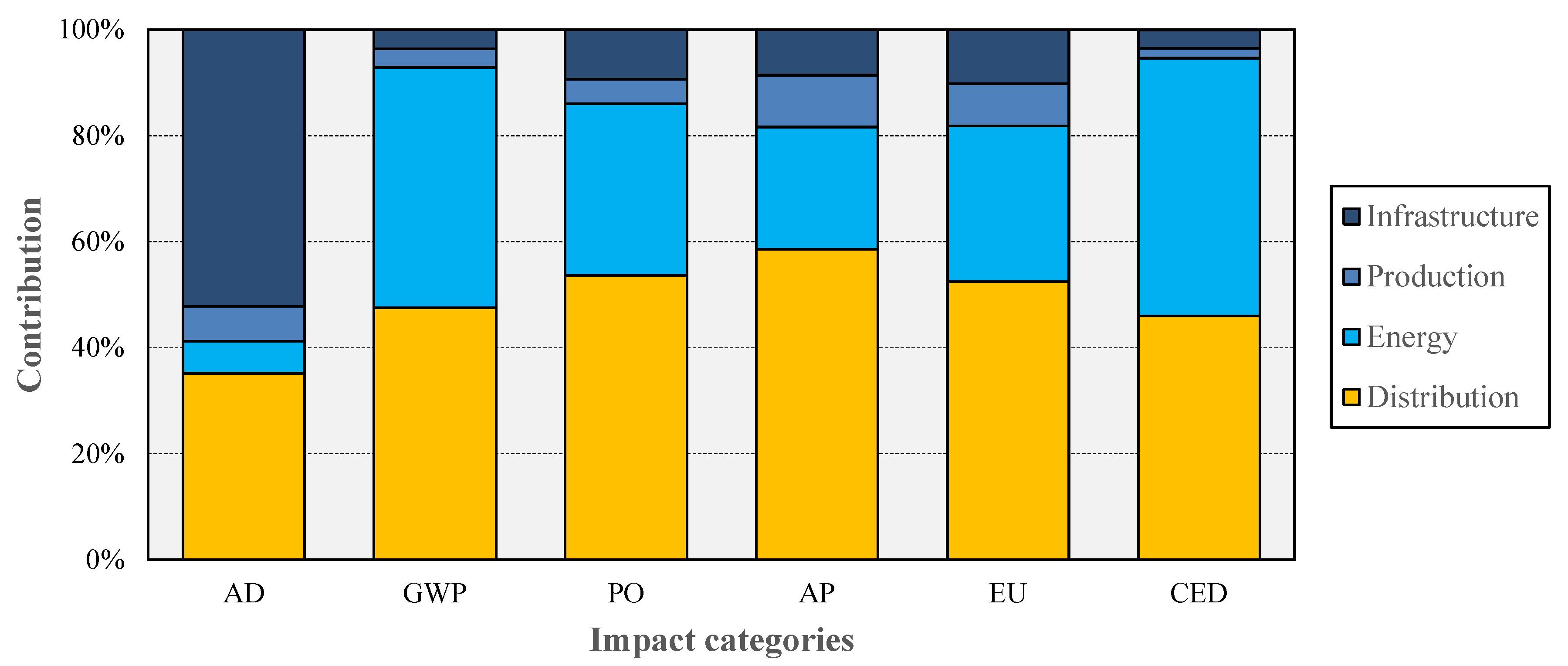

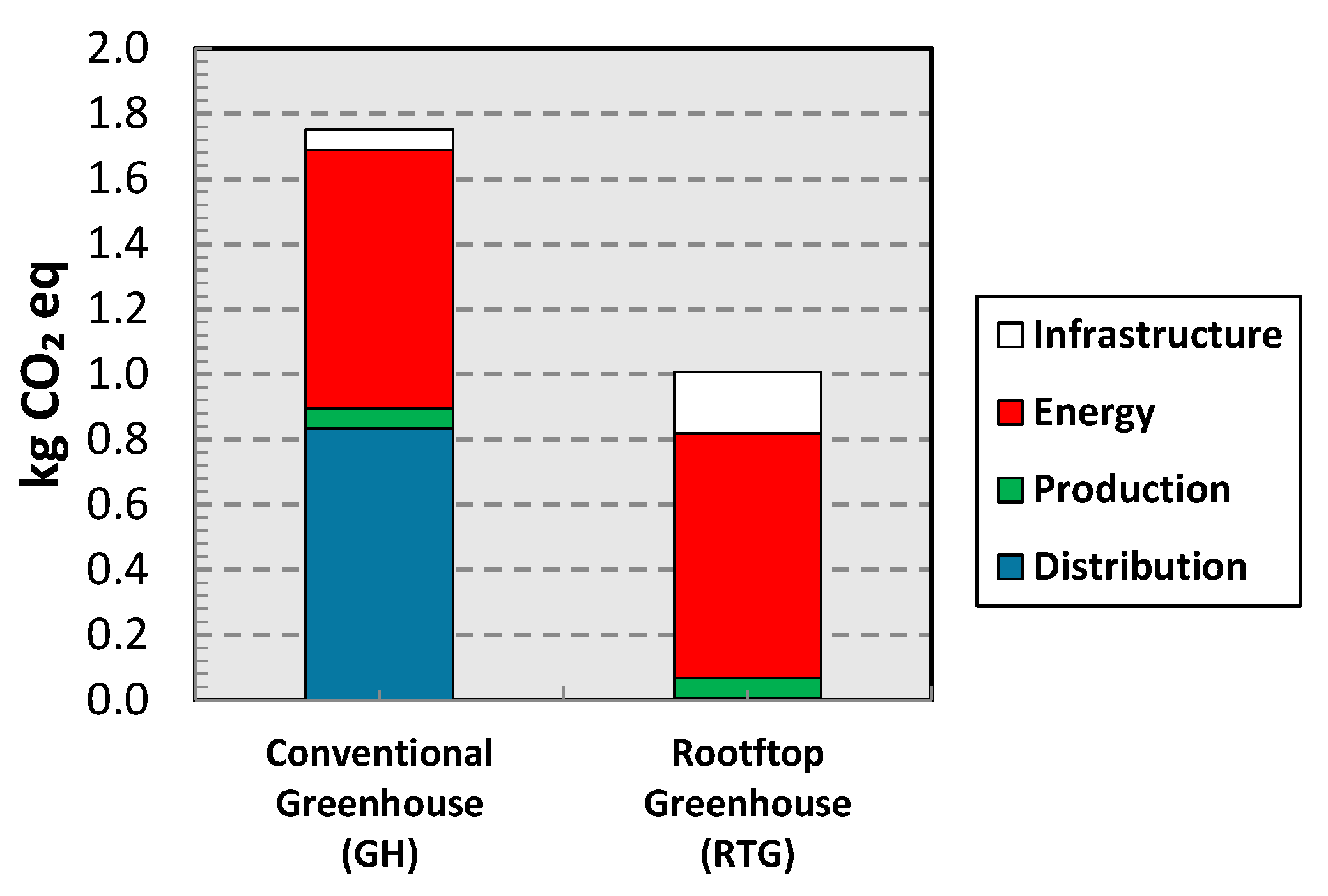
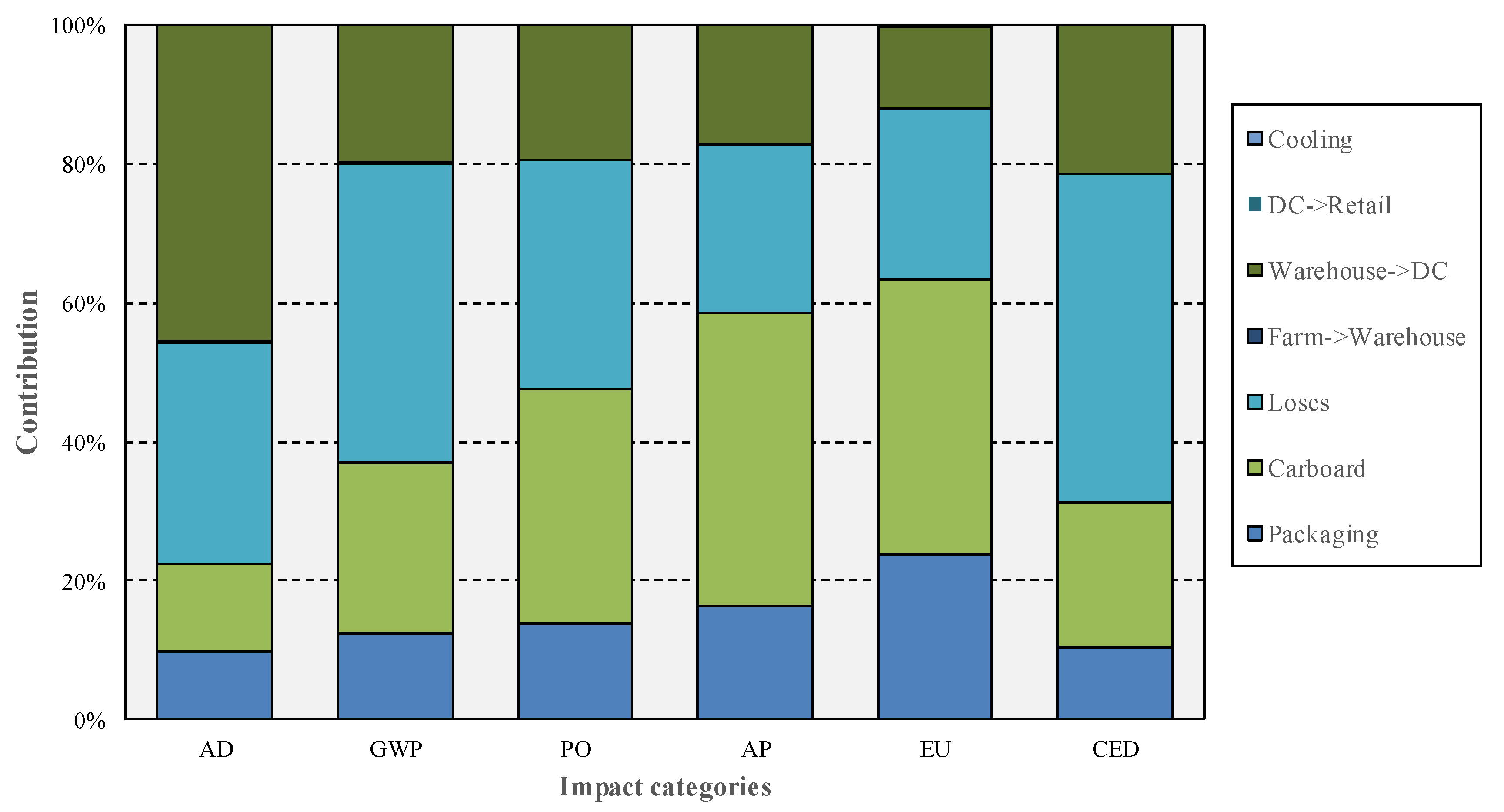
| Impact Category | Acronym | Unit |
|---|---|---|
| Abiotic depletion | AD | kg Sb eq |
| Global warming (GWP100a) | GWP | kg CO2 eq |
| Photochemical oxidation | PO | kg C2H4 eq |
| Acidification | AP | kg SO2 eq |
| Eutrophication | EU | kg PO4 eq |
| Cumulative energy demand | CED | MJ |
| IC | Unit | Total | Infra | Production | Energy | Distribution |
|---|---|---|---|---|---|---|
| AD | kg Sb eq | 5.4 × 10−6 | 2.8 × 10−6 | 3.6 × 10−7 | 3.3 × 10−7 | 1.9 × 10−6 |
| GWP | kg CO2 eq | 1.7 × 100 | 6.3 × 10−2 | 6.2 × 10−2 | 7.9 × 10−1 | 8.3 × 10−1 |
| PO | kg C2H4 eq | 2.6 × 10−4 | 2.4 × 10−5 | 1.2 × 10−5 | 8.4 × 10−5 | 1.4 × 10−4 |
| AP | kg SO2 eq | 4.1 × 10−3 | 3.5 × 10−4 | 4.0 × 10−4 | 9.6 × 10−4 | 2.4 × 10−3 |
| EU | kg PO4 eq | 1.5 × 10−3 | 1.6 × 10−4 | 1.2 × 10−4 | 4.6 × 10−4 | 8.2 × 10−4 |
| CED | MJ | 2.5 × 101 | 8.9 × 10−1 | 4.8 × 10−1 | 1.2 × 101 | 1.1 × 101 |
| IC | Unit | Total | Infra | Production | Energy | Distribution |
|---|---|---|---|---|---|---|
| AD | kg Sb eq | 3.0 × 10−6 | 2.2 × 10−6 | 3.6 × 10−7 | 3.5 × 10−7 | 9.4 × 10−9 |
| GWP | kg CO2 eq | 1.0 × 100 | 1.8 × 10−1 | 6.2 × 10−2 | 7.5 × 10−1 | 5.1 × 10−3 |
| PO | kg C2H4 eq | 1.6 × 10−4 | 7.2 × 10−5 | 1.2 × 10−5 | 7.8 × 10−5 | 9.6 × 10−7 |
| AP | kg SO2 eq | 2.6 × 10−3 | 1.1 × 10−3 | 4.0 × 10−4 | 1.0 × 10−3 | 1.9 × 10−5 |
| EU | kg PO4 eq | 1.1 × 10−3 | 3.9 × 10−4 | 1.2 × 10−4 | 6.2 × 10−4 | 9.8 × 10−6 |
| CED | MJ | 1.4 × 101 | 1.9 × 100 | 4.8 × 10−1 | 1.1 × 101 | 6.1 × 10−2 |
Publisher’s Note: MDPI stays neutral with regard to jurisdictional claims in published maps and institutional affiliations. |
© 2020 by the authors. Licensee MDPI, Basel, Switzerland. This article is an open access article distributed under the terms and conditions of the Creative Commons Attribution (CC BY) license (http://creativecommons.org/licenses/by/4.0/).
Share and Cite
Torres Pineda, I.; Cho, J.H.; Lee, D.; Lee, S.M.; Yu, S.; Lee, Y.D. Environmental Impact of Fresh Tomato Production in an Urban Rooftop Greenhouse in a Humid Continental Climate in South Korea. Sustainability 2020, 12, 9029. https://doi.org/10.3390/su12219029
Torres Pineda I, Cho JH, Lee D, Lee SM, Yu S, Lee YD. Environmental Impact of Fresh Tomato Production in an Urban Rooftop Greenhouse in a Humid Continental Climate in South Korea. Sustainability. 2020; 12(21):9029. https://doi.org/10.3390/su12219029
Chicago/Turabian StyleTorres Pineda, Israel, Jeong Hwa Cho, Dongkeun Lee, Sang Min Lee, Sangseok Yu, and Young Duk Lee. 2020. "Environmental Impact of Fresh Tomato Production in an Urban Rooftop Greenhouse in a Humid Continental Climate in South Korea" Sustainability 12, no. 21: 9029. https://doi.org/10.3390/su12219029
APA StyleTorres Pineda, I., Cho, J. H., Lee, D., Lee, S. M., Yu, S., & Lee, Y. D. (2020). Environmental Impact of Fresh Tomato Production in an Urban Rooftop Greenhouse in a Humid Continental Climate in South Korea. Sustainability, 12(21), 9029. https://doi.org/10.3390/su12219029





